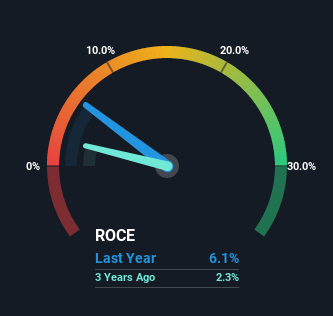- Germany
- /
- Other Utilities
- /
- XTRA:EOAN
We Like These Underlying Return On Capital Trends At E.ON (ETR:EOAN)

If you're not sure where to start when looking for the next multi-bagger, there are a few key trends you should keep an eye out for. Typically, we'll want to notice a trend of growing return on capital employed (ROCE) and alongside that, an expanding base of capital employed. Ultimately, this demonstrates that it's a business that is reinvesting profits at increasing rates of return. So on that note, E.ON (ETR:EOAN) looks quite promising in regards to its trends of return on capital.
Understanding Return On Capital Employed (ROCE)
For those that aren't sure what ROCE is, it measures the amount of pre-tax profits a company can generate from the capital employed in its business. To calculate this metric for E.ON, this is the formula:
Return on Capital Employed = Earnings Before Interest and Tax (EBIT) ÷ (Total Assets - Current Liabilities)
0.061 = €5.7b ÷ (€146b - €53b) (Based on the trailing twelve months to June 2022).
Therefore, E.ON has an ROCE of 6.1%. Even though it's in line with the industry average of 6.1%, it's still a low return by itself.
Our analysis indicates that EOAN is potentially undervalued!

Above you can see how the current ROCE for E.ON compares to its prior returns on capital, but there's only so much you can tell from the past. If you'd like, you can check out the forecasts from the analysts covering E.ON here for free.
The Trend Of ROCE
We're delighted to see that E.ON is reaping rewards from its investments and is now generating some pre-tax profits. The company was generating losses five years ago, but now it's earning 6.1% which is a sight for sore eyes. Not only that, but the company is utilizing 111% more capital than before, but that's to be expected from a company trying to break into profitability. This can indicate that there's plenty of opportunities to invest capital internally and at ever higher rates, both common traits of a multi-bagger.
What We Can Learn From E.ON's ROCE
To the delight of most shareholders, E.ON has now broken into profitability. And given the stock has remained rather flat over the last five years, there might be an opportunity here if other metrics are strong. That being the case, research into the company's current valuation metrics and future prospects seems fitting.
E.ON does have some risks, we noticed 3 warning signs (and 2 which don't sit too well with us) we think you should know about.
While E.ON may not currently earn the highest returns, we've compiled a list of companies that currently earn more than 25% return on equity. Check out this free list here.
Valuation is complex, but we're here to simplify it.
Discover if E.ON might be undervalued or overvalued with our detailed analysis, featuring fair value estimates, potential risks, dividends, insider trades, and its financial condition.
Access Free AnalysisHave feedback on this article? Concerned about the content? Get in touch with us directly. Alternatively, email editorial-team (at) simplywallst.com.
This article by Simply Wall St is general in nature. We provide commentary based on historical data and analyst forecasts only using an unbiased methodology and our articles are not intended to be financial advice. It does not constitute a recommendation to buy or sell any stock, and does not take account of your objectives, or your financial situation. We aim to bring you long-term focused analysis driven by fundamental data. Note that our analysis may not factor in the latest price-sensitive company announcements or qualitative material. Simply Wall St has no position in any stocks mentioned.
About XTRA:EOAN
E.ON
Operates as an energy company in Germany, the United Kingdom, Sweden, the Netherlands, rest of Europe, and internationally.
Undervalued low.


